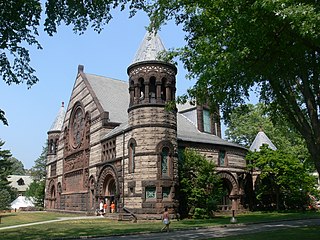
Watsonian Football Club is a rugby union club based in Edinburgh and part of the Scottish Rugby Union. The club is connected with George Watson's College as a club for former pupils, and changed its policy in the 1980s to be a fully open club, welcoming players of all abilities regardless of whether they attended the school or not. It is one of a small number of rugby union clubs entitled to call itself a 'football club', rather than a 'rugby football club'. Watsonians run a number of sides; the top male side plays in the FOSROC Super Series tournament, the Women's side plays in the Tennents Scottish Women's Premiership Scottish Rugby's Women's League

John Stewart Kennedy was a Scottish-born American businessman, financier and philanthropist. He was a member of the Jekyll Island Club on Jekyll Island, Georgia along with J.P. Morgan and William Rockefeller among others.

William Appleton Potter was an American architect who designed numerous buildings for Princeton University, as well as municipal offices and churches. He served as a Supervising Architect of the Treasury from 1874 to 1877.

Rugby union in Scotland in its modern form has existed since the mid-19th century. Scotland has one of the oldest rugby union traditions and has introduced various innovations including rugby sevens.
Howard Potter was an American industrialist, investment banker, diplomat and philanthropist, and a partner in Brown Bros. & Co.
Glasgow District is a Scottish amateur rugby union team which plays in the amateur Scottish Inter-District Championship. The side evolved into the professional provincial side Glasgow Warriors when the Scottish Rugby Union embraced professionalism. However the amateur district is still used for the representation of amateur players in the Inter-District Championship; and this amateur championship guides the selection of Scotland Club XV international players.
William Kidston was a Scotland international rugby union player. He could play as a half-back or three-quarters.
Charles Chalmers Bryce was a Scottish rugby union international who represented Scotland in the 1873–74 Home Nations rugby union matches.
George Raphael Fleming was a Scottish rugby union international player. He was born in Cathcart, Renfrewshire.
Henry Melvill Napier was a Scottish rugby union international who represented Scotland in the 1876–77 Home Nations rugby union matches, 1877–78 Home Nations rugby union matches, 1878–79 Home Nations rugby union matches and 1879–80 Home Nations rugby union matches. Napier was also a noted engineer and shipbuilder.
John Neilson was a Scottish international rugby union player. He played as a forward.
William MacKintosh MacLeod was a Scotland international rugby union player.
Charles Villar was an Scotland international rugby union player.

Greenwich Point is one of four beaches located in Greenwich, Connecticut. The beach sits on a peninsula jutting into Long Island Sound. It is a popular spot for Greenwich families to spend the day. Visitors to Greenwich Point typically jog, walk, or cycle around the Point, fish, boat, or swim in the Long Island Sound, study nature, or sunbathe.
Alexander Petrie was a Scotland international rugby union player who represented Scotland from 1873 to 1880.
Lieutenant-Colonel Alexander Kenneth Stewart was a Scotland international rugby union player who represented Scotland from 1873 to 1875.
Rae Tod was a Scottish rugby union player. He was the 81st President of the Scottish Rugby Union.
Finlay Kennedy was a Scotland international rugby union footballer. He played as a Prop.
Euan Kennedy is a former Scotland international rugby union player.
John Tod was a Scotland international rugby union player. He was nicknamed 'The Prince of Dribblers' and it is said that he introduced the dribbling game to rugby union. Tod, himself, rated the later Watsonian player and Scotland international William Cownie as a much better dribbler of the rugby ball than he was, saying that Cownie was the prettiest dribbler he had ever seen touch a rugby ball.





